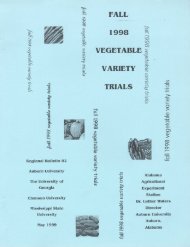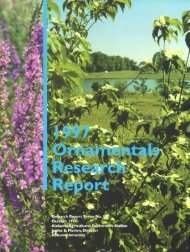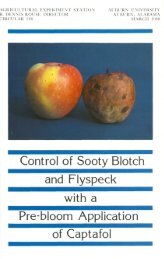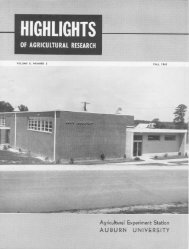MARKETING CHRISTMAS TREES - Auburn University Repository
MARKETING CHRISTMAS TREES - Auburn University Repository
MARKETING CHRISTMAS TREES - Auburn University Repository
You also want an ePaper? Increase the reach of your titles
YUMPU automatically turns print PDFs into web optimized ePapers that Google loves.
20<br />
ALABAMA AGRICULTURAL EXPERIMENT STATION<br />
The average number of these trees distributed in the past 5 years<br />
was about 280,000 per year.<br />
Tree survival rates vary greatly depending on handling seedlings,<br />
planting techniques, and growth conditions. Survival rates<br />
of around 50 per cent were found on several private plantations<br />
of Arizona cypress (3). Some foresters believe that these trees<br />
are more exacting in their planting requirements than pines (9).<br />
There is also the question of marketability of surviving trees.<br />
Furthermore, a considerable number of trees are planted as ornamentals<br />
and for other purposes. Thus, it seems that not more<br />
than half of these trees could be expected to figure in the Christmas<br />
tree market.<br />
Based on the foregoing, it appears that present plantation plantings<br />
might take care of about a third of the State's Christmas tree<br />
needs. More intensive tree culture including careful farming,<br />
"limb" or "stump" culture, cultivation, fertilization to speed<br />
growth, and protection of trees from insects and diseases would,<br />
of course, increase the number of trees available. Likewise, pines<br />
could conceivably increase in popularity and saleability as Christmas<br />
trees. However, there was little indication that plantation<br />
trees were a major factor in the cedar tree market in 1956. Apparently,<br />
plantation trees were the sole factor in the Arizona<br />
cypress market. Prices quoted for these trees, as well as lack of<br />
complaints of leftover trees, indicate that they are finding an acceptable<br />
place in the entire Christmas tree market.<br />
The Alabama Christmas tree producer should give attention to<br />
the full market potential within the State. However, his interest<br />
should not stop there when the national market potential represents<br />
about 40 million trees of all kinds. Of course, there are costs<br />
to be considered.<br />
Assuming trees of equal consumer appeal, the producing area<br />
that can produce, harvest, and place trees in the hands of the consumer<br />
at least cost would be expected to dominate the market.<br />
The South, in which Alabama is centrally located, has production<br />
and harvesting advantages as previously noted. Furthermore, it<br />
has marketing advantages, for at least a large segment of the<br />
consuming population, particularly in costs of moving trees to<br />
market. To be sure, costs of local assembly may not be greatly<br />
different in the North and South. Established producing areas,<br />
which tend to group on both sides of the northern border of the<br />
United States, may have some freight advantage to population
















